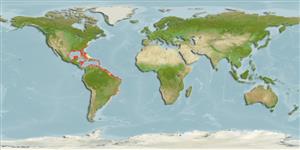Environment: milieu / climate zone / depth range / distribution range
Ekologi
laut; payau berasosiasi dengan karang; kisaran kedalaman ? - 48 m (Ref. 9710). Subtropical; 42°N - 35°S, 98°W - 34°W
Western Atlantic to Southwest Atlantic: Rhode Island, USA to southeastern Brazil.
Length at first maturity / Size / Weight / umur
Maturity: Lm 10.8 range ? - ? cm
Max length : 38.8 cm TL jantan/; (Ref. 26340); common length : 20.0 cm TL jantan/; (Ref. 3821); Berat maksimum terpublikasi: 400.00 g (Ref. 5217)
Duri punggung (Keseluruhan (total)) : 0; duri punggung lunak (Keseluruhan (total)) : 11 - 12; Duri dubur: 0; Sirip dubur lunak: 11. Greenish above, pale yellow to white below; back has series of pale lines and arcs suggesting concentric circles with intersecting lines. No other puffer has this color pattern (Ref. 26938).
Commonly found in bays, tidal creeks and protected coastal waters, especially on seagrass beds, and in brackish water. Rare or absent on coral reefs. Does not form schools, but may form huge aggregates. Hides in the sand when frightened (Ref. 9710). Feeds mainly on bivalves, gastropods, foraminiferans and several other benthic invertebrates specially crustaceans, which it crushes with its powerful teeth (Ref. 35237). To ward off predators, it inflates itself like a balloon. Highly toxic; used to poison cats and dogs (Ref. 2861).
Spawning season is from late spring to early fall at Biscayne Bay, Florida. Mean length at first maturity is over 13 cm TL.
Robins, C.R. and G.C. Ray, 1986. A field guide to Atlantic coast fishes of North America. Houghton Mifflin Company, Boston, U.S.A. 354 p. (Ref. 7251)
Status IUCN Red List (Ref. 130435: Version 2024-1)
ancaman kepada manusia
Poisonous to eat (Ref. 3821)
penggunaan manusia
Perikanan: tidak ada kepentingan
Alat, peralatan
laporan khas
muat turun XML
Sumber internet
Estimates based on models
Preferred temperature (Ref.
123201): 22.9 - 28, mean 25.6 °C (based on 472 cells).
Phylogenetic diversity index (Ref.
82804): PD
50 = 0.5000 [Uniqueness, from 0.5 = low to 2.0 = high].
Bayesian length-weight: a=0.02089 (0.01739 - 0.02511), b=2.93 (2.88 - 2.98), in cm total length, based on LWR estimates for this species (Ref.
93245).
Trophic level (Ref.
69278): 3.4 ±0.41 se; based on food items.
Generation time: 2.2 ( na - na) years. Estimated as median ln(3)/K based on 2
growth studies.
Daya lenting (Ref.
120179): Rendah, Waktu penggandaan populasi minimum 4.5 - 14 tahun (K=0.51; rel. fec=1.146 eggs/ g body weight).
Fishing Vulnerability (Ref.
59153): Low vulnerability (22 of 100).
Nutrients (Ref.
124155): Calcium = 32.1 [11.0, 104.4] mg/100g; Iron = 0.721 [0.352, 1.490] mg/100g; Protein = 19.9 [17.7, 22.1] %; Omega3 = 0.248 [0.115, 0.488] g/100g; Selenium = 17.2 [7.6, 39.1] μg/100g; VitaminA = 29.4 [8.7, 102.1] μg/100g; Zinc = 0.919 [0.596, 1.423] mg/100g (wet weight);
